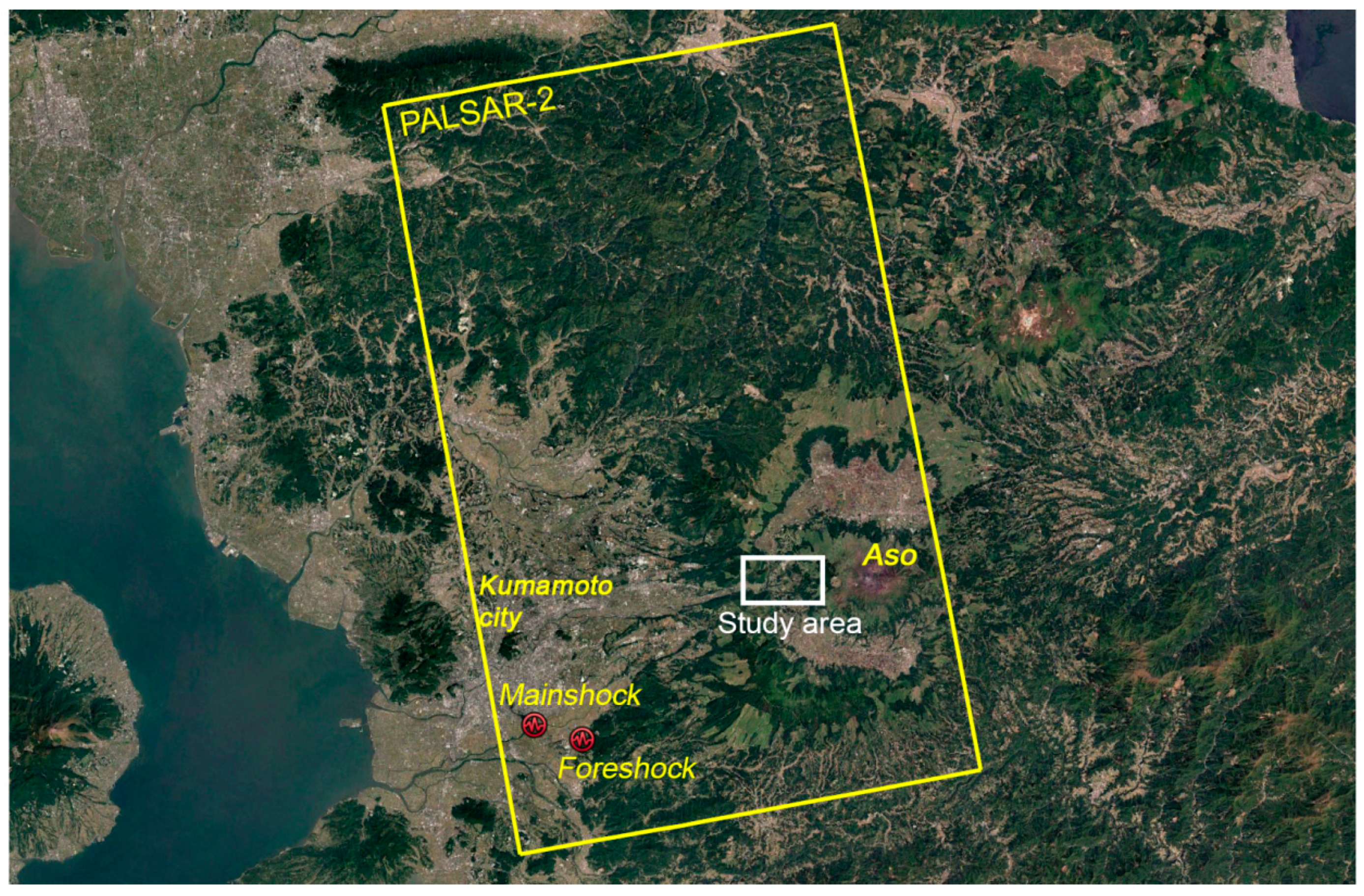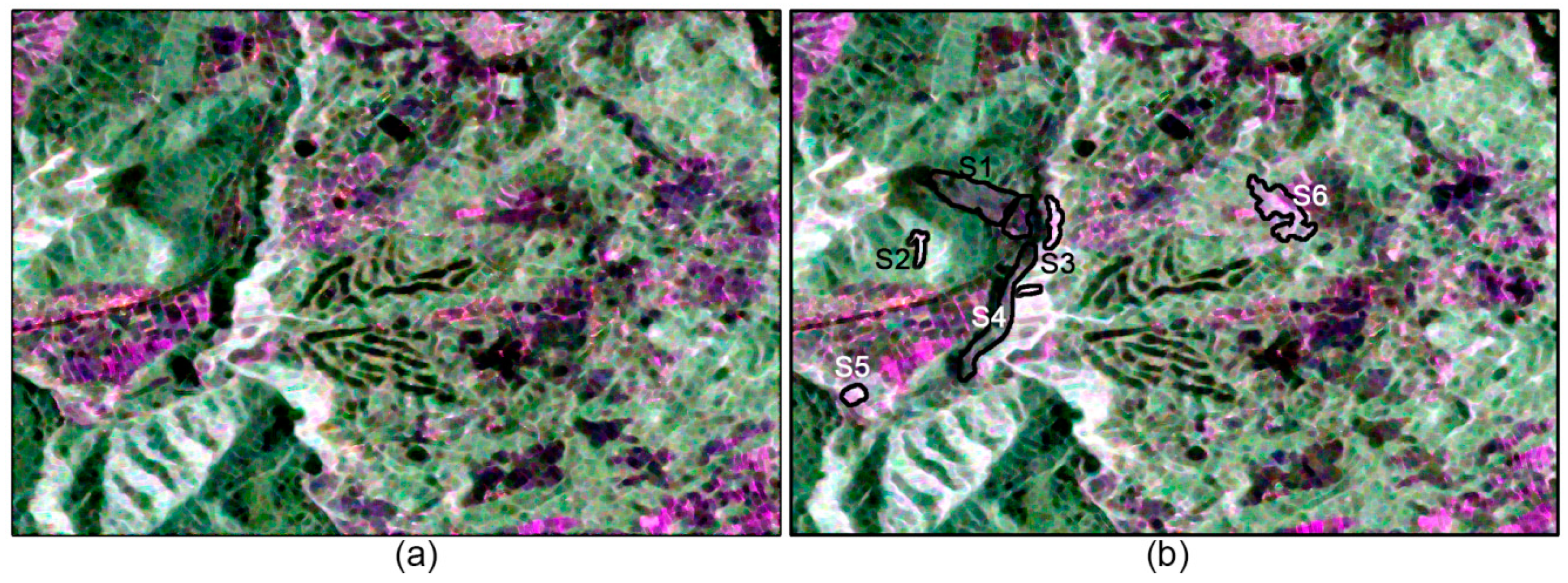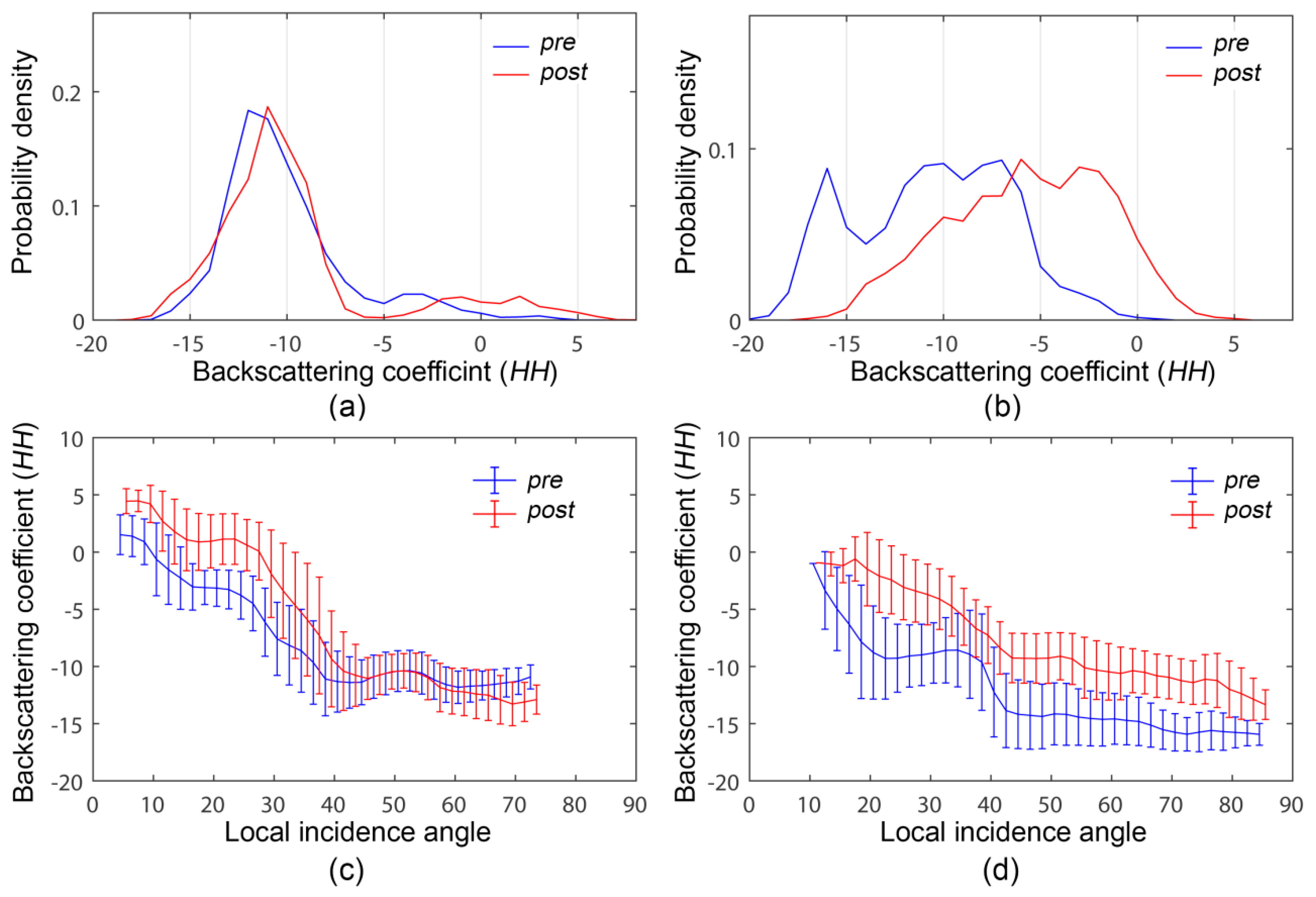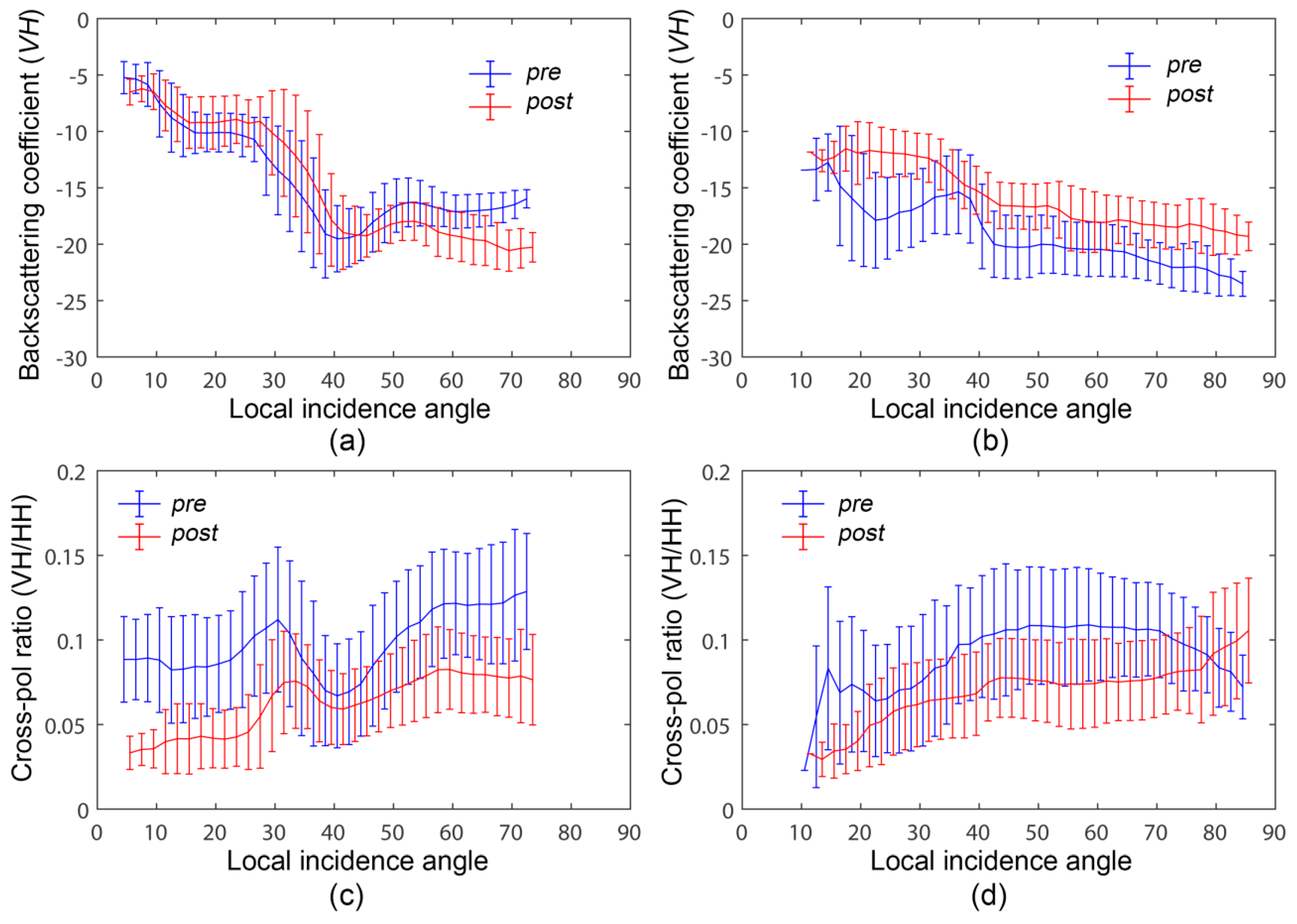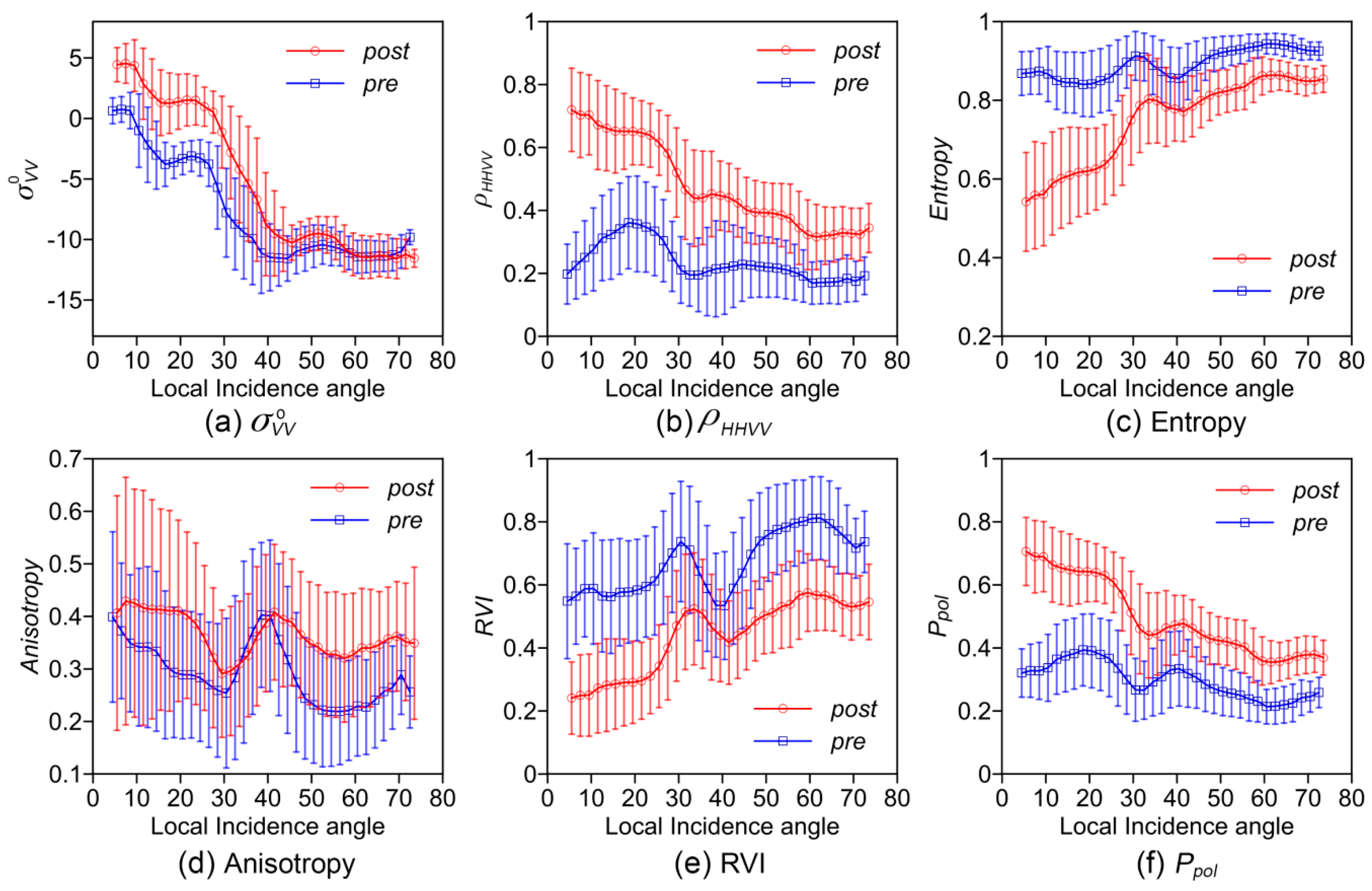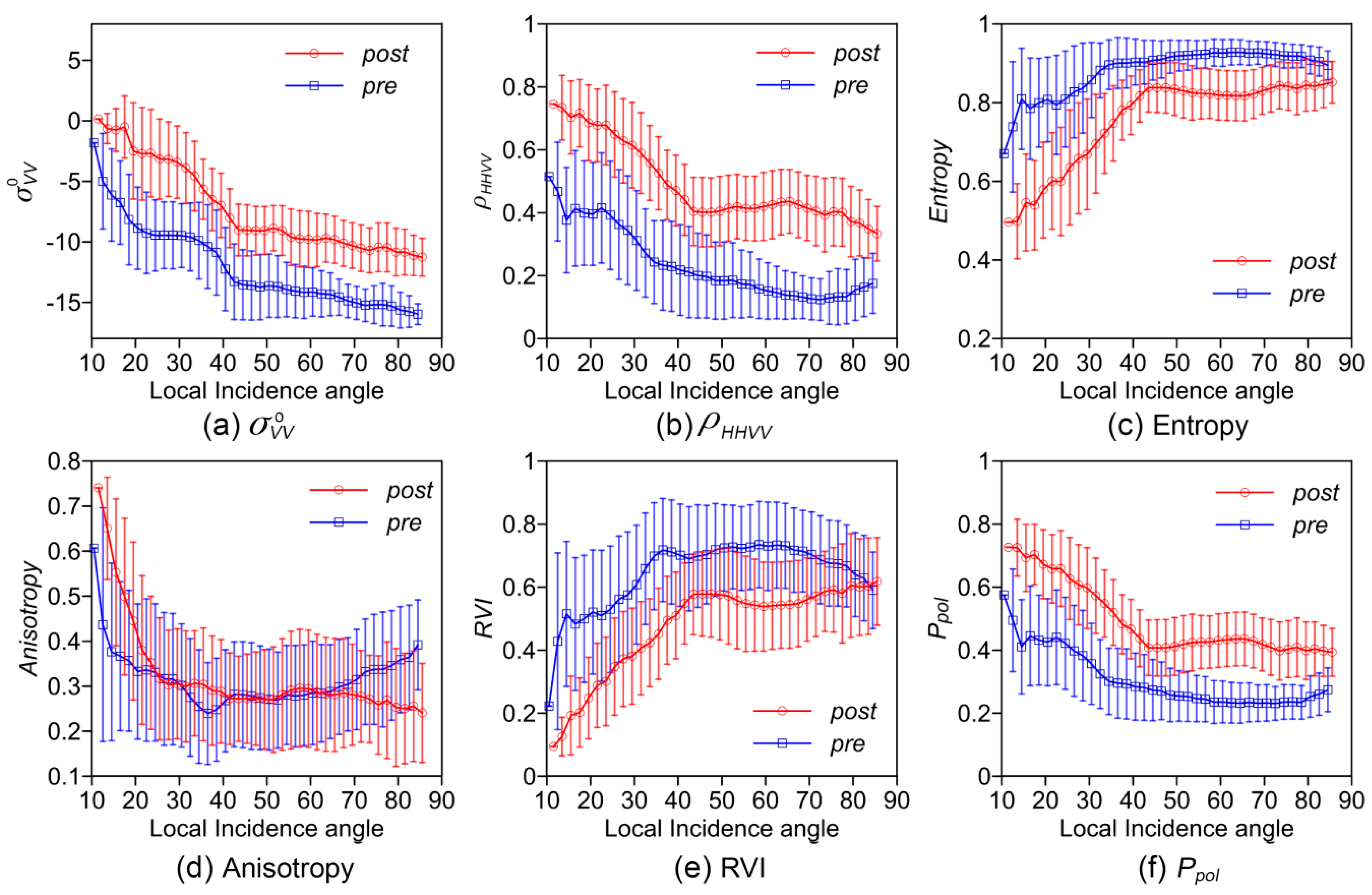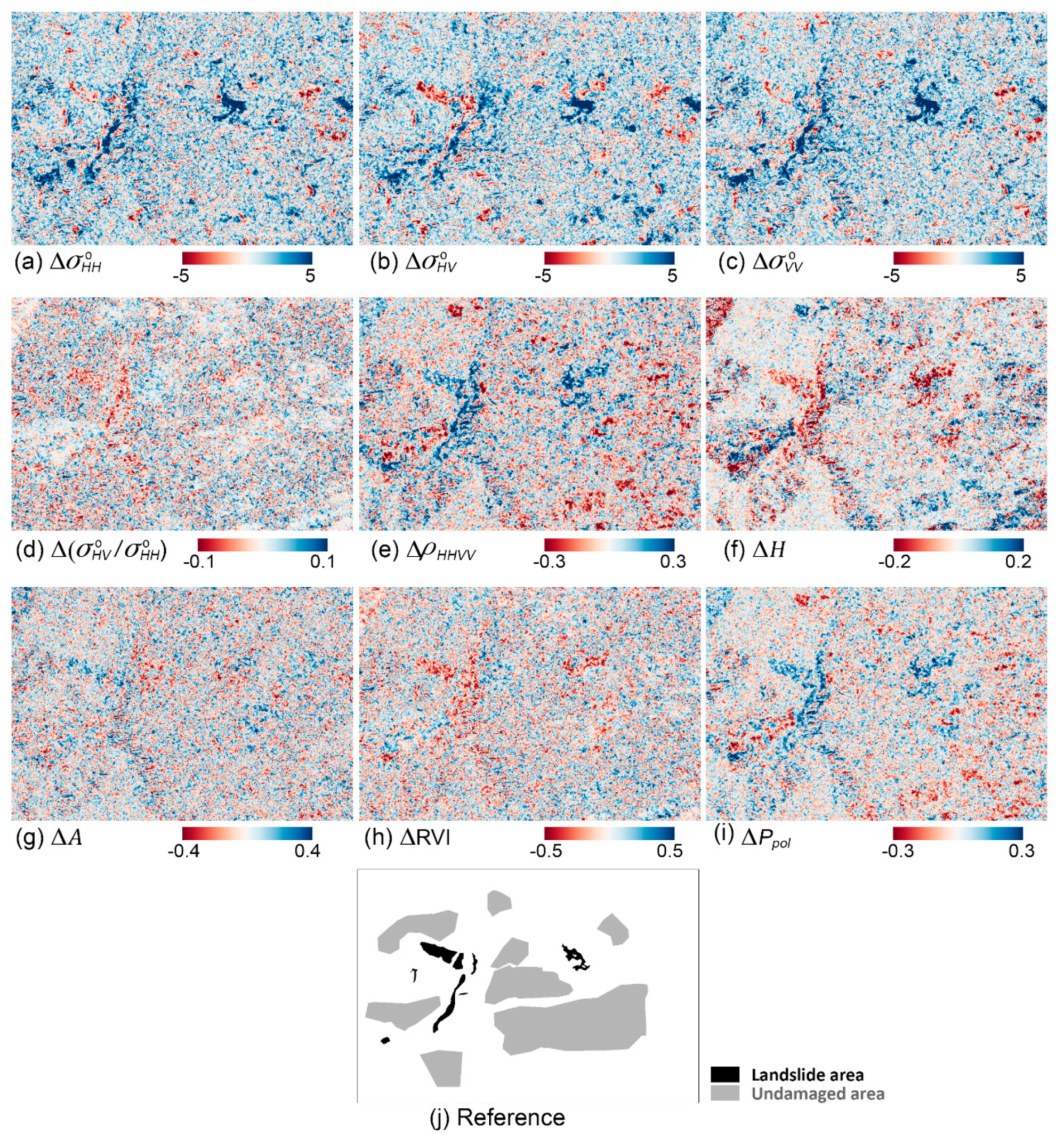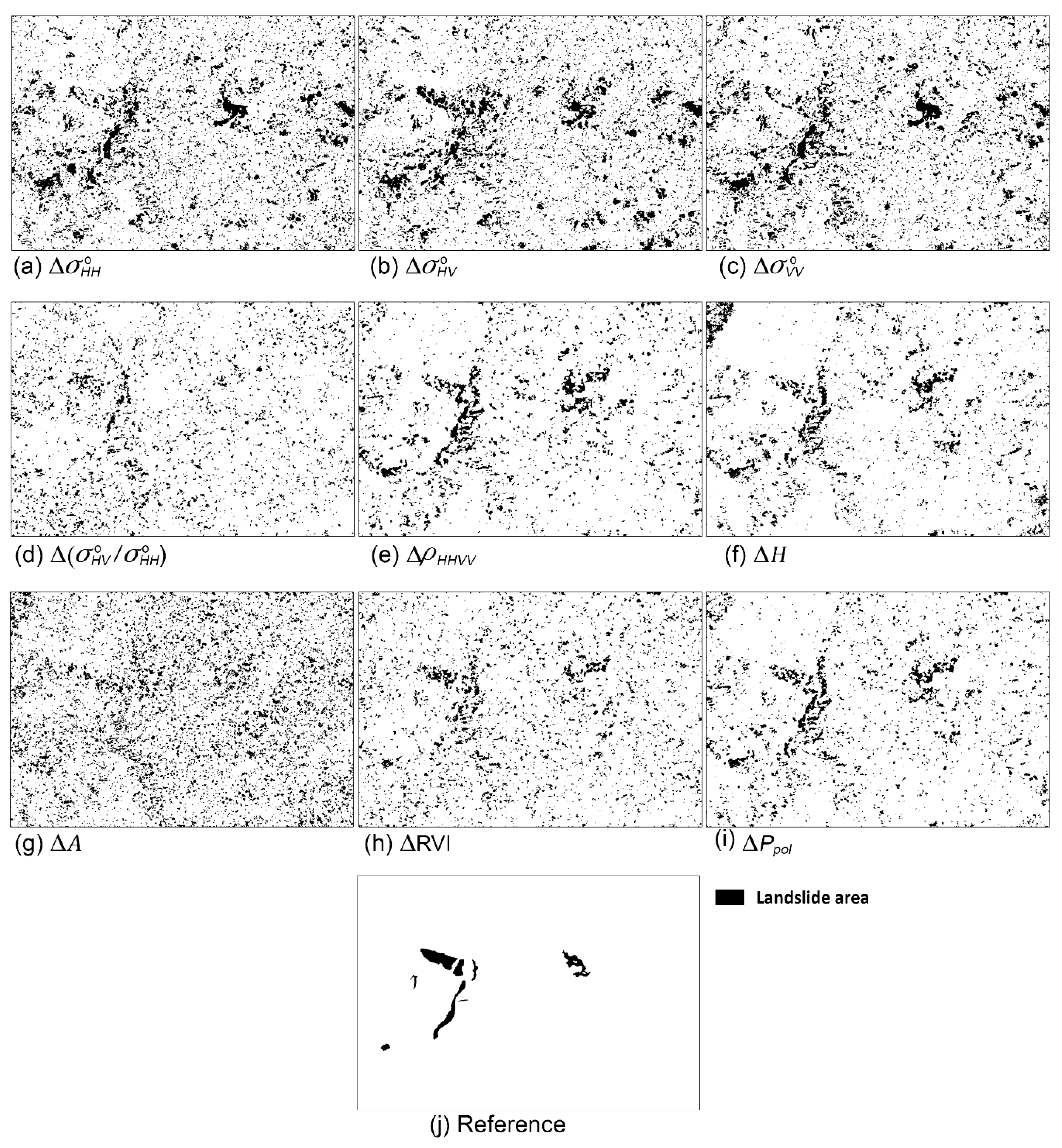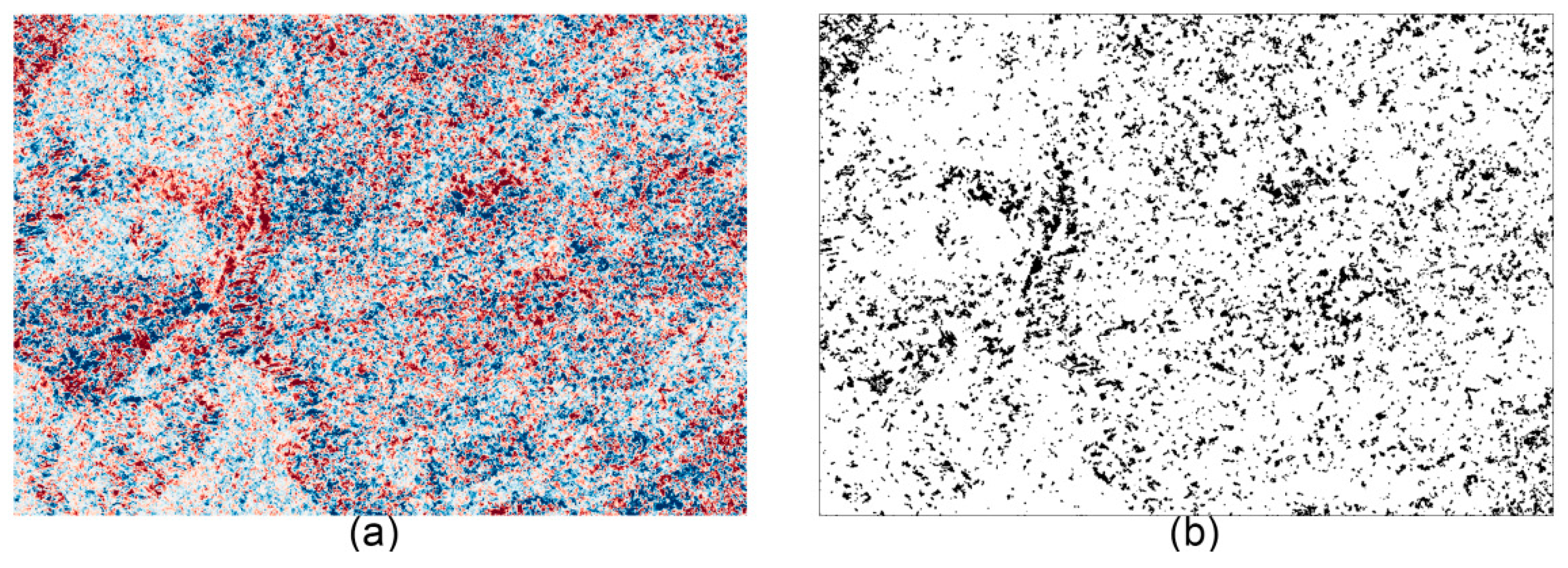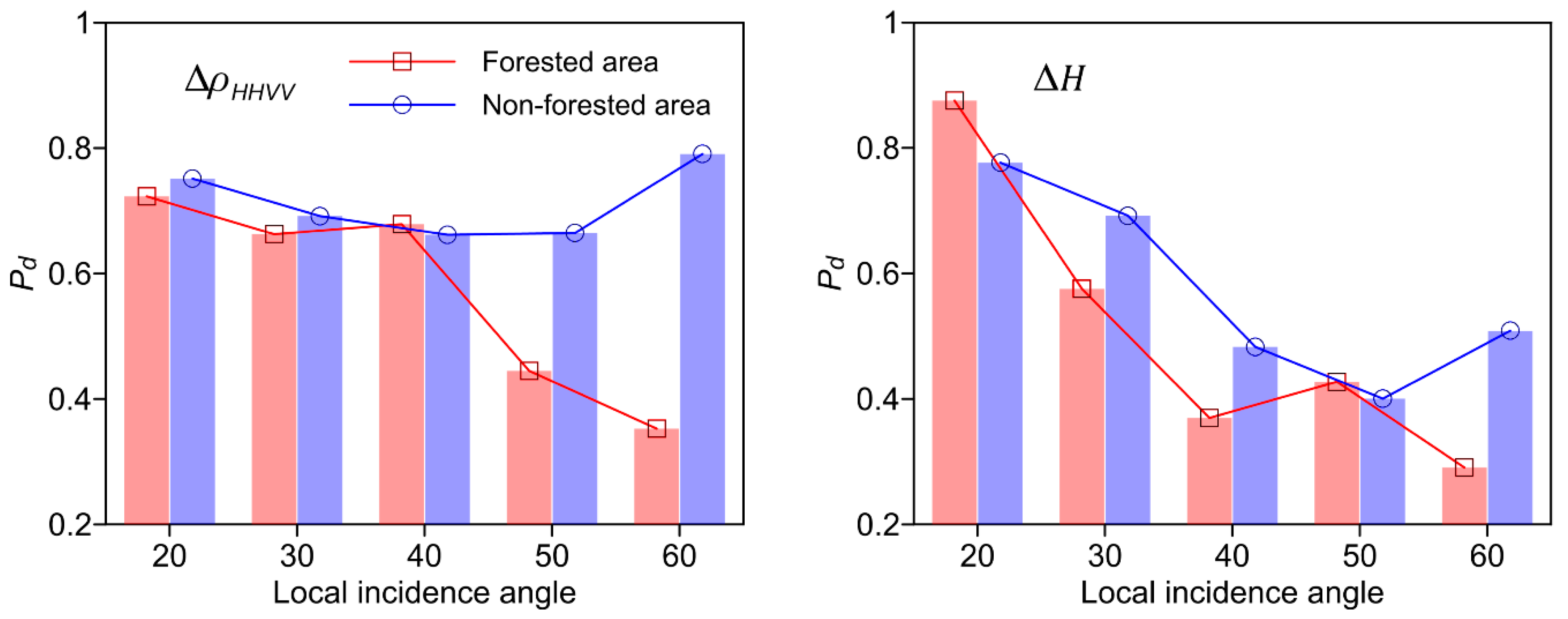1. Introduction
Landslides are one of the most widespread natural disasters. Producing a landslide map or event inventory map is an essential task to understand the extent and magnitude of landslides. Remote sensing techniques can accelerate the production of landslide maps for large spatial scales [
1]. Since the landslide triggering event often hampers the acquisition of optical remote sensing data, the microwave remote sensing techniques including Synthetic Aperture Radar (SAR) can be very useful tools for near real-time landslides detection. The application of SAR images related to landslides has been mainly studied for monitoring slow-moving landslides through interferometric SAR technique based on phase information of SAR images [
2]. However, the use of SAR amplitude information for the landslide application is not widespread.
Most studies on the detection of event landslides using SAR amplitude information have been carried out using polarimetric SAR data to overcome difficulties in discriminating landslide areas from land cover classes. Czuchlewski et al. [
3] employed L-band airborne polarimetric SAR data (AIRSAR) and examined the usability of polarimetric parameters for detecting a large slope failure triggered by an earthquake in Taiwan. The scattering characteristics of the landslide region were able to be identified by the eigenvalue-eigenvector decomposition [
4]. After the launch of space-borne polarimetric SAR systems, several studies have been conducted to analyze the availability of satellite SAR data for landslide detection. Yonezawa et al. [
5] applied another type of polarimetric decomposition, such as the model-based decomposition [
6], as well as the eigenvalue-eigenvector decomposition to examine landslides triggered by the earthquake in Japan by using L-band ALOS PALSAR data. The model-based decomposition enables interpreting radar images more easily by fitting elementary scattering models, such as the surface scattering, the double-bounce scattering, and the volume scattering, into the polarimetric SAR observation. They found that the surface scattering component can be dominant among other scattering mechanisms in landslide areas. Shibayama et al. [
7] applied a similar approach to ALOS-2 PALSAR-2 data, which observed several landslide scars triggered by a typhoon. They examined the scattering properties of landslide areas by an improved version of the model-based decomposition [
8] in relation to the local slopes. Wang et al. [
9] also applied similar decomposition techniques to examine X-band polarimetric response of landslide areas in China using airborne polarimetric SAR data. Plank et al. [
10] further investigated X-band scattering properties of landslide areas using space-borne TerraSAR-X data. Instead of full quad-polarimetric parameters, they used the dual-polarization eigenvalue parameter of TerraSAR-X data and the spectral vegetation index of optical data to generate landslide maps in two different landslide sites in USA and Russia.
Most space-borne SAR systems have been operating in different polarimetric modes, such as the single-polarization (single-pol), dual-polarization (dual-pol), and full or quad-polarization (quad-pol) modes, to meet various operational requirements on the resolution and coverages. In this study, we analyzed the different polarimetric SAR observables, which can be obtained from different polarimetric modes, for detecting landslide areas. However, since there is a lack of studies on the appropriate polarimetric mode for observing disasters such as landslides, it can be difficult to carry out emergency observation effectively. This study aims to discuss how one can actually map the landslide area using each polarimetric mode. Although there were several studies to identify landslides using polarimetric SAR data, few studies performed detection and analyzed accuracies. In this study, we also analyzed how much detectability can be expected in the landslide map produced from each polarimetric observation. Several landslides triggered by the 2016 Kumamoto earthquake in Japan were investigated using the PALSAR-2 data of the ALOS-2 satellite acquired in pre- and post-landslide conditions. This paper is organized as follows: In
Section 2, the study area and a description of the acquired SAR data used for this paper are discussed. In
Section 3, radar scattering behaviors observed by single-, dual- and quad-pol parameters are discussed. Methods to generate landslide map and the experimental results are presented in
Section 4. Discussion on the detection results in relation to the previous studies and environmental conditions are given in
Section 5, and summaries and concluding remarks are presented in
Section 6.
2. Study Area and Data
A series of earthquakes occurred in Kumamoto, Kyushu Island, Japan in 2016 [
11]. The first major shock (foreshock) occurred at 21:26 Japanese Standard Time (JMT) on 14 April 2016 with the moment magnitude of Mw 6.2. Subsequently, on 16 April at 01:26 JMT, a second strong shock (mainshock) occurred nearby with the magnitude of Mw 7.0. The foreshock occurred at a depth of 11 km. The focal mechanism exhibited right-lateral strike-slip faulting with a NNW–SSE tension axis. The epicenter of the mainshock is approximately 4.5 km northwest of the epicenter of the foreshock.
Figure 1 shows the epicenter of the foreshock and mainshock. The focal mechanism of the mainshock is a right-lateral strike-slip fault with a tension axis in the NW-SE direction. It triggered numerous landslides in and around Minamiaso, which is located in the western part of Aso caldera [
12].
Among several observation modes of the ALOS-2 PALSAR-2 sensor, a fully polarimetric quad-pol mode data observed on 21 April 2016, about 5 days after the mainshock, was obtained in this study. In addition, a pre-event quad-polarization PALSAR-2 data observed on 3 December 2015 was obtained with the same observation mode. To evaluate landslide-induced changes of SAR signals, a study area (white rectangle in
Figure 1) was selected in which several landslides and slope failures occurred by the Kumamoto earthquakes.
The PALSAR-2 images of the study area acquired before and after the earthquake are shown in
Figure 2. Six landslides sites (marked in black in
Figure 2b) for the examination of radar scattering responses were manually selected by the literature [
12] and the aerial photos [
13]. Three of the selected landslides (S1, S2, and S3) occurred in forested areas, while the other three (S4, S5, and S6) occurred in non-forested grasslands and shrublands. Since a landslide generally occurs in sloping terrain, geometric distortions of SAR image should be corrected before further analysis of SAR signals. To represent the SAR images as geometrically similar to the map coordinates, all SAR images were converted to the multilook covariance matrix format [
14]. Then, the range-Doppler orthorectification was performed by using SRTM (Shuttle Radar Topography Mission) global 1 arc second digital elevation model (DEM). In addition, polarimetric speckle filtering using the IDAN filter [
15] was applied to all PALSAR-2 data to reduce speckle.
4. Landslide Detection
One of the goals of remote sensing data analysis for a landslide event is to generate the landslide map or landslide inventory map. A simple way to map landslide affected areas is to compare remote sensing data acquired at pre- and post-landslide conditions by image differencing. Consider two
polarimetric parameters,
and
, acquired at before and after the landslide, respectively.
Figure 7 illustrates the difference image,
, for the different polarimetric parameters.
Figure 7a–d corresponds to the single- and dual-pol parameters, and
Figure 7e–f corresponds to the quad-pol parameters. It also shows a manually generated reference image which illustrates regions of interests for landslide damaged areas and undamaged forest and agricultural areas. It is seen that changes in polarimetric parameters highlight the damaged areas except for the cross-pol ratio and the anisotropy. Three intensities
,
, and
show landslide-induced changes, but the direction of changes vary depending on the slope direction. The eigenvalue parameters and the co-pol coherence exhibit one-directional changes for landslide areas from high depolarization states at the pre-landslide condition to low depolarization states at the post-landslide condition. However, the amount of changes in the landslide areas and the level of general changes unrelated to landslides vary across the polarimetric parameters.
After generating the difference image, the landslide map can be generated by a change detection approach. It aims to assign each pixel of the difference image to either changed class
or unchanged background class
. One of the simple and unsupervised solutions to this problem, which is important in emergency observation, is to select the global threshold in the difference image. In order to better reflect the characteristic changes of polarimetric parameters occurred in the landslide areas and other undamaged areas, change detection was carried out considering the negatively changed (
) and the positively changed (
) classes in this study. To find multiple thresholds from the difference image, we adopted the Expectation–Maximization (EM) thresholding method [
22,
23,
24,
25].
We assume that the probability distribution of the difference image
is a mixture of three density components associated with the negatively and positively changed classes and unchanged background class, that is,
where
,
, and
are the prior probabilities of negatively changed, positively changed, and unchanged classes, respectively, and
,
, and
are their conditional probability density functions. Both the unknown prior probabilities and the conditional probability density functions can be calculated iteratively by the EM procedure until convergence. If we further assume the Gaussian density functions, the prior and conditional probabilities of i
th class where
at (t + 1) iteration is given by:
where the conditional probability density function of
ith class is described by the mean
and the standard deviation
. Once the final parameter estimates of the three probability distributions are obtained, the optimal threshold values
and
can be derived according to the maximum a posterior decision rule, that is, solving following equations with respect to the variable
:
Since the EM-based threshold is applied exclusively to the pixel values of the difference image, the change detection usually provides noisy classification results. To further improve the detection results, spatial contextual information can be considered after obtaining three probability distributions and preliminary decisions from two threshold values. The Markov Random Field (MRF) model can provide a useful tool for characterizing contextual information [
23,
24,
25,
26]. The final change detection map after obtaining class labels for each pixel
can be generated by minimizing the energy function
such as:
where
is the class conditional energy function. Under the Gaussian assumption, it can be written as:
The contextual energy function
describes spatial contextual information in a local spatial neighborhood system
given as:
It counts the number of pixels in the neighborhood system assigned to the same class as pixel with delta function and the parameter tunes the importance of spatial context. In this study, we used the second-order neighborhood system containing eight neighboring pixels with .
After obtaining the class decision among the negatively and positively changed classes and unchanged background class for each pixel, the final landslide map can be generated accordingly with the characteristic changes of polarimetric parameters. Each pixel
of the detection map is assigned to either 1 or 0, where 1 indicates landslide damaged areas and 0 indicates undamaged areas according to:
Appropriate types of change
for different polarimetric parameters (
Table 1) were selected based on the analysis on the polarimetric scattering characteristics of landslide areas discussed in the previous Section.
Figure 8 illustrates the final binary decision results for landslide-related changes derived from the selected polarimetric parameters. Comparing the detection results with the reference landslide map in
Figure 8i, it is seen that the landslide affected areas can be successfully identified by the automatic change detection from quad-polarization SAR observations. In order to evaluate the detection result quantitatively, several accuracy metrics were considered including the detection rate (Pd), false-alarm rate (Pfa), overall accuracy (OA), and Kappa coefficient (Kappa) [
27].
Table 2 shows the accuracy analysis results for each binary classification result. The entries highlighted in bold correspond to the best and second-best polarimetric parameters of a specific accuracy metric. Detection rates of around 60% can be obtained using the co-pol coherence
, the entropy
, and the polarizing contribution
. Changes of single-pol scattering intensities can also provide high detection rates but suffer from significant false alarms at the same time. The OA and Kappa provide an overall idea of detectability. Both accuracy metrics show that
and
are two best parameters for landslide detection. The OA shows much higher values than other accuracy metrics for all polarimetric parameters because of the low proportion of landslide areas in all pixels selected for accuracy analysis. In this case, the overall detection performance of different polarimetric parameters can be better evaluated by the Kappa. According to Kappa, we can expect about two times better performance by using quad-pol parameters with the significantly less false alarm errors than single- or dual-pol parameters.
6. Conclusions
Due to various triggering mechanisms, landslides are widespread in many parts of the world. With a significant triggering event, slope failures can be sparse and widely distributed across a large area. Remote sensing technologies, particularly with air-borne or space-borne SAR sensors, can provide timely and critical information to assess landslide distributions over large areas. Nonetheless, studies on the systematic use of SAR data to produce event landslide maps are rare. In this context, this study discussed an automatic detection and mapping strategy of landslide areas from polarimetric SAR data. This study focused mainly on the usability of different polarimetric parameters of single-, dual-, and quad-pol modes observations for deducing information about landslide areas.
The experimental analysis on the characteristics of landslide-induced changes for different polarimetric parameters showed that, in general, SAR observations were largely influenced by the local slopes in which the landslide occurred. This is because the microwave scattering mechanisms can vary not only by landslide-induced land cover changes but also local incidence angle variations in the sloping terrain as reported in the previous study [
25]. Consequently, single- or dual-pol SAR observations were not able to represent various landslide areas that occurred in different topographic conditions. However, quad-pol parameters indicating signal depolarization properties revealed noticeable landslide-induced temporal changes for all local incidence angle ranges.
To produce a landslide map, a simple change detection method based on EM thresholding and MRF contextual classification was also presented in this study. For an automatic identification of landslide areas, binary decision strategies based on the characteristic scattering properties of landslide areas were proposed. The accuracy assessment results showed that the depolarization parameters, such as the co-pol coherence and polarizing contribution, can identify areas affected by landslides in about 18.9 km2 study area with a detection rate of 60%, a false-alarm rate of 5%, and a Kappa coefficient of 0.45. On the other hand, the single- or dual-pol parameters can only be expected to provide half the accuracy with significant false-alarms in areas with temporal variations independent of landslides. It is worth noting that the results were obtained exclusively from the polarimetric SAR data. The detection algorithm is unsupervised and fully automatic. Therefore, the proposed detection accuracy can be considered to be the minimum values that can be expected from the quad-pol scattering mechanism indicators if a rapid survey is required. There is enough room to improve accuracy through advanced change detection or supervised classification methods. In particular, considering the effects of environmental conditions on the SAR observations, it is considered that the detection accuracy can be improved by using ancillary information such as DEM and optical remote sensing data.
